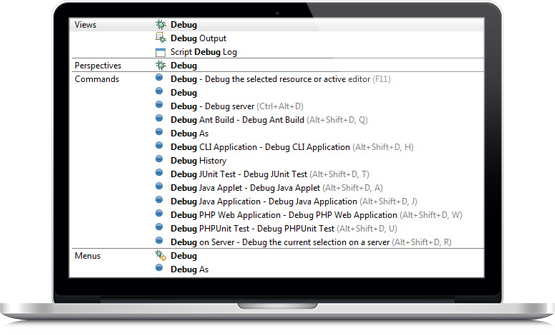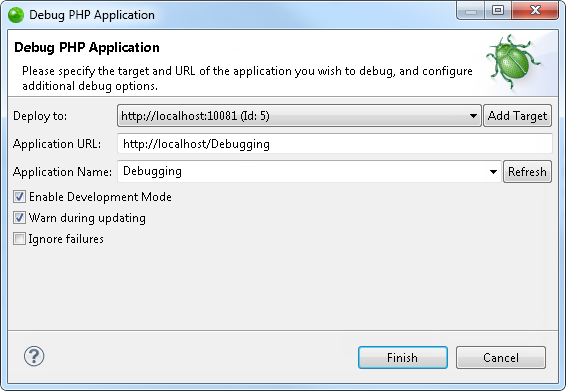

- #Zend studio 10 debug mac os x
- #Zend studio 10 debug update
- #Zend studio 10 debug upgrade
- #Zend studio 10 debug software
- #Zend studio 10 debug code
In the former, you can elect to have the Zend Firefox and Internet Explorer toolbars added to your browsers. The two major ones are termed Configuration and Installation. Installation and Start UpĪfter downloading the Zend Studio installation file for your particular operating system, there are several steps to installing the product. For both editions, customers can choose either version 5.5 or 6.0, depending on whether they are interested in using Eclipse.
#Zend studio 10 debug upgrade
The introductory prices, as of this writing, are $299 and $498, during the first 30 days after the 22 January 2008 release The Standard edition will continue to be priced at $99, and does not include technical support, though purchasers of the product can always upgrade to the Professional edition. The cost for the Professional edition, for a one-year support subscription, is normally $399 USD, and $717 for three years. The system requirements for Zen Platform are also provided.
#Zend studio 10 debug mac os x
However, the system requirements page does specify that Zend Studio runs on Windows 2000, XP, 2003, and Vista (32 bit only), Linux x86 and x86-64, and Mac OS X 10.4 with an Intel x86 or a PowerPC G4 or G5 processor.
#Zend studio 10 debug software
Unlike the system requirements specifications for most software applications, the Zend site does not mention anything about disk space usage.

When installed on disk, the former consumes about 433 MB, while the latter consumes 157 MB. Including Eclipse and PDT into this newest version of Zend Studio is likely the primary reason why its installation file is much larger than that of version 5.5 - namely, over 290 MB versus about 68 MB. In terms of size on disk, Eclipse itself is certainly not a small product, with the installation files of its various flavors currently varying from 63 MB to 153 MB. In this review, I will examine both editions - often comparing one to the other - but focusing on the Professional edition, since it is the future product path.
#Zend studio 10 debug code
The Professional edition adds a host of additional capabilities, including code analysis, optimization, version control, and source management - covered in more detail below. The Standard edition offers a complete source code editor (that supports PHP 4 and 5) and an interactive debugger for local PHP scripts. Zend Studio comes in two editions: Standard and Professional. Product Editions, Requirements, and Pricing Version 5.5 will be the last non-Eclipse release of Zend Studio.

Jeff Koo, who is involved in Zend public relations and kindly provided information on both products, noted that Zend plans to continue maintaining version 5.5, to allow customers to make the transition on their own schedule. Zend Studio version 6.0 represents a new generation of the product, encompassing all of the functionality of version 5.5, which will continue to be maintained by Zend, with maintenance release version 5.5.1 coming out in January 2008. It also utilizes the PHP Development Tools (PDT) framework. As a foundation, it uses Eclipse, an extensible open source platform for software development that is growing in functionality and widespread usage every year.
#Zend studio 10 debug update
Zend Studio for Eclipse is the company's latest update of its PHP IDE, and carries a version number of 6.0. The organization bills itself as "The Zend Company", and not without reason, because it has a history of supporting the language, since 1997, including development and contribution of the Zend Engine, which is now PHP's execution engine. One clear example of this is Zend Studio, created and distributed by Zend, headquartered in Cupertino, California. But during the past several years, the tide has turned, and now Web languages such as PHP are receiving a lot more software vendor attention. Web developers, on the other hand, have not enjoyed an equally long history of project- and sanity-saving IDEs. But for most programmers, it is time and effort well invested, because it pays dividends in the form of faster development of more solid code.

As with any robust tool, these IDEs can take some getting used to, and a fair amount of time to thoroughly learn all of their features. This article was published by O'Reilly Network, , as a feature article on their website.ĭesktop application developers - using Java, C++, or any similar language - are accustomed to being able to choose from a number of powerful integrated development environments (IDEs), each of which typically bring together the functionality of a programmer's editor, a source-level debugger, source code management, a built-in FTP client, and more.


 0 kommentar(er)
0 kommentar(er)
